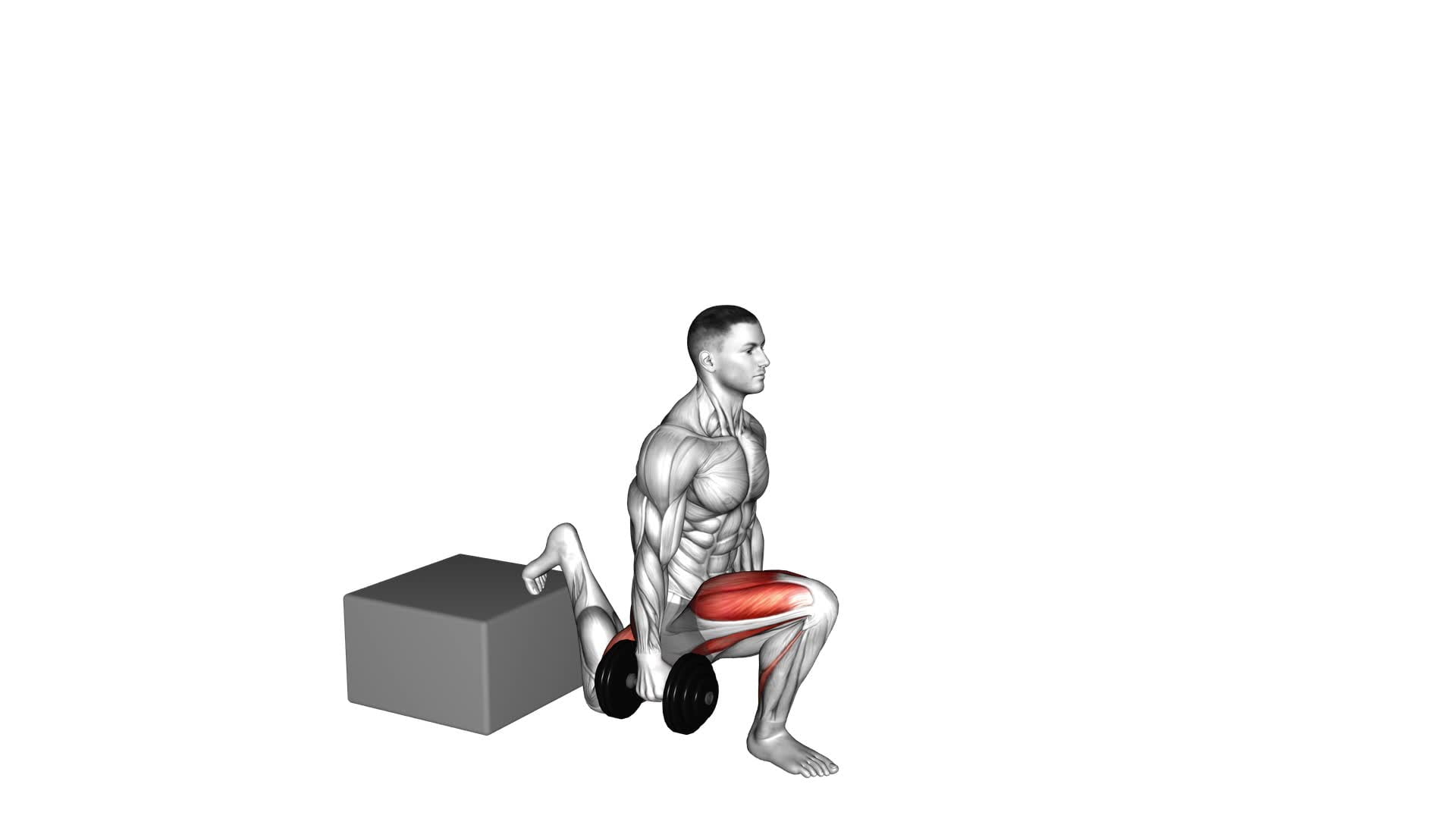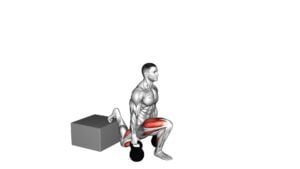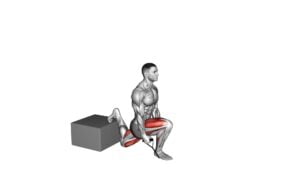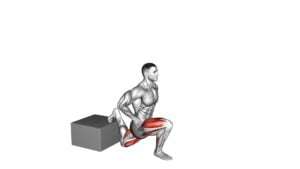Dumbbell Single Leg Split Squat With Low Box – Video Exercise Guide & Tips

In this video exercise guide, you'll discover how to master the Dumbbell Single Leg Split Squat with a low box. This challenging exercise offers numerous benefits, from improving balance and stability to strengthening your legs and glutes.
Watch This Exercise Video
You'll learn the proper technique and form to ensure maximum effectiveness, as well as tips for increasing intensity and avoiding common mistakes.
Get ready to take your lower body workout to the next level with this targeted exercise.
Key Takeaways
- Incorporates unilateral training to correct muscle imbalances and improve overall strength and stability
- Leads to improved lower body strength, stability, and balance
- Helps prevent injuries by addressing muscle imbalances
- Can be modified by using a lower box or performing without weights
Benefits of the Dumbbell Single Leg Split Squat
The dumbbell single leg split squat offers numerous benefits for your lower body strength and stability. One of the main benefits of this exercise is that it incorporates unilateral training. Unilateral training, or training one side of the body at a time, helps to correct muscle imbalances and improve overall strength and stability. By focusing on one leg at a time, you can identify and address any weaknesses or imbalances that may exist.
Another benefit of the dumbbell single leg split squat is that it allows for variations of the split squat. You can perform this exercise with a low box, which helps to increase the range of motion and target the muscles in your glutes and hamstrings even more. This variation also requires more stability and control, as you have to balance on the elevated surface.
Incorporating the dumbbell single leg split squat into your workout routine can lead to improved lower body strength, stability, and balance. It can also help to prevent injuries by addressing any muscle imbalances that may exist.
Proper Technique and Form for the Exercise
To perform the dumbbell single leg split squat with low box properly, focus on maintaining balance and stability while targeting your lower body muscles. Here are some key tips to ensure you execute the exercise correctly:
- Start by standing in front of a low box or bench, with your back facing it.
- Place one foot on top of the box, positioning it slightly in front of you.
- Hold a dumbbell in each hand, allowing them to hang by your sides.
- Lower your body by bending the knee of the leg on the box, while simultaneously lowering your other knee towards the ground.
- Ensure that your front knee stays in line with your toes and doesn't extend past them.
Common mistakes to avoid when performing this exercise include:
- Allowing your front knee to cave inward.
- Leaning too far forward, which can strain the lower back.
- Not maintaining an upright posture throughout the movement.
If you're looking for modification options, you can try using a lower box or bench to decrease the range of motion. Additionally, you can perform the exercise without weights until you build enough strength and stability to add resistance.
Targeted Muscle Groups and How to Activate Them
Activate your targeted muscle groups by focusing on proper form and engaging the appropriate muscles during the dumbbell single leg split squat with low box exercise.
To ensure effective muscle activation, it's important to understand the targeted muscle groups and use proper muscle activation techniques.
The primary muscle groups targeted during this exercise are the quadriceps, glutes, and hamstrings. By focusing on these muscles, you can maximize the benefits of unilateral training. Unilateral training, which involves working one side of the body at a time, helps to improve muscle imbalances, enhance stability, and increase overall strength and performance.
To activate your quadriceps, focus on pushing through your front heel as you stand up from the squat position. Engage your glutes by squeezing them at the top of the movement, and maintain a stable core throughout the exercise. To activate your hamstrings, focus on maintaining tension in the back leg as you descend into the squat position.
By concentrating on these muscle activation techniques, you can optimize the benefits of the dumbbell single leg split squat with low box exercise. Remember to start with lighter weights and gradually increase as you improve your form and strength.
Incorporating this exercise into your training routine can help you develop stronger and more balanced lower body muscles.
Tips for Increasing Intensity and Progression
To effectively increase the intensity and progression of the dumbbell single leg split squat with low box exercise, consider incorporating these tips:
- Increase the weight: Gradually increase the weight of the dumbbells used during the exercise to challenge your muscles and promote progression.
- Decrease rest time: Shorten the rest periods between sets to keep your heart rate elevated and intensify the workout.
- Add plyometric movements: Incorporate explosive movements, such as jump squats or box jumps, after completing the split squat to further engage your leg muscles and increase the overall intensity.
- Modify the range of motion: Increase the depth of your squat by lowering your back knee closer to the ground or by using a lower box. This will engage your leg muscles more intensely.
- Use tempo variations: Experiment with different tempos during the exercise, such as slowing down the lowering phase or pausing at the bottom of the movement. This will challenge your muscles in new ways and stimulate further progression.
By implementing these progression tips and increasing the intensity of your dumbbell single leg split squat with low box exercise, you can continue to challenge your muscles, promote growth, and achieve your fitness goals.
Remember to listen to your body and progress at a pace that's suitable for your fitness level.
Common Mistakes to Avoid for Optimal Results
You should avoid these common mistakes for optimal results when performing the dumbbell single leg split squat with low box exercise.
First and foremost, it's crucial to maintain proper form throughout the movement. Avoid leaning too far forward or backward, as this can put unnecessary strain on your lower back and increase the risk of injury. Keep your chest up and core engaged to ensure stability and balance.
Another common mistake to avoid is using too much weight too soon. It's important to gradually increase the weight as your strength and stability improve. Starting with lighter weights will allow you to focus on proper form and avoid straining your muscles.
Additionally, beginners should consider modifying the exercise to suit their fitness level. If you find it challenging to maintain balance or perform the exercise with proper form, you can use a higher box or omit the dumbbell altogether. This will help you build strength and stability before progressing to the full exercise.
Lastly, it's crucial to listen to your body and stop if you experience any pain or discomfort. Pushing through pain can lead to injury and setbacks in your fitness journey. Take breaks as needed and consult with a fitness professional if you have any concerns or questions.
Frequently Asked Questions
How Many Sets and Reps Should I Do for the Dumbbell Single Leg Split Squat?
For the dumbbell single leg split squat, it's important to consider the number of sets and reps that you should do.
To determine this, factors such as your fitness level, goals, and overall program should be taken into account.
It's always a good idea to start with a lower number, such as 2-3 sets of 8-12 reps per leg, and gradually increase as you progress.
Remember to focus on maintaining proper form and technique throughout the exercise.
Can I Do This Exercise if I Have Knee or Hip Issues?
If you have knee or hip issues, it's important to make modifications to the dumbbell single leg split squat. Discussing modifications and alternatives for this exercise can help you find suitable options that won't aggravate your condition.
Is It Better to Use a Low Box or a Higher One for This Exercise?
When deciding between a low box and a higher one for the dumbbell single leg split squat, there are a few things to consider.
Using a low box can provide a greater range of motion and challenge your muscles more. However, it also requires more balance and stability.
On the other hand, using a higher box can be beneficial for those with knee or hip issues as it reduces the depth of the squat.
Ultimately, choose the height that suits your fitness level and goals.
Can I Perform This Exercise Without Dumbbells?
Yes, you can perform this exercise without dumbbells. There are alternative variations of the split squat that don't require any weights.
However, using dumbbells can provide additional benefits to the exercise. They help increase the resistance and challenge your muscles, leading to more strength and muscle growth.
How Long Should I Rest Between Sets of Dumbbell Single Leg Split Squats?
To maximize the benefits of the dumbbell single leg split squat, it's important to consider the rest time between sets. Resting allows your muscles to recover and perform at their best.
The ideal rest time for this exercise is typically around 60-90 seconds. This gives your muscles enough time to recover without allowing them to cool down too much.
Conclusion
In conclusion, the dumbbell single leg split squat with a low box is a highly effective exercise for targeting and activating the leg muscles.
By following proper technique and form, you can maximize the benefits of this exercise and avoid common mistakes.
Additionally, incorporating tips for increasing intensity and progression can help you continually challenge your muscles and see optimal results.
Keep up the good work and enjoy the benefits of this challenging exercise!

Author
Years ago, the spark of my life’s passion ignited in my mind the moment I stepped into the local gym for the first time. The inaugural bead of perspiration, the initial endeavor, the very first surge of endorphins, and a sense of pride that washed over me post-workout marked the beginning of my deep-seated interest in strength sports, fitness, and sports nutrition. This very curiosity blossomed rapidly into a profound fascination, propelling me to earn a Master’s degree in Physical Education from the Academy of Physical Education in Krakow, followed by a Sports Manager diploma from the Jagiellonian University. My journey of growth led me to gain more specialized qualifications, such as being a certified personal trainer with a focus on sports dietetics, a lifeguard, and an instructor for wellness and corrective gymnastics. Theoretical knowledge paired seamlessly with practical experience, reinforcing my belief that the transformation of individuals under my guidance was also a reflection of my personal growth. This belief holds true even today. Each day, I strive to push the boundaries and explore new realms. These realms gently elevate me to greater heights. The unique combination of passion for my field and the continuous quest for growth fuels my drive to break new ground.







